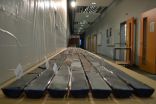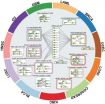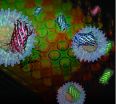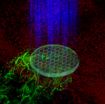Even with global warming cold air outbreaks will remain
Just because the climate is warming doesn't mean Cold Air Outbreaks are going away, especially in Southwestern Canada and Northwestern United States. Overall, global climate models agree that there will be a dip in the duration of Cold Air Outbreaks across North America, but the percentage of decrease is consistently smaller from Western Canada to the Upper Midwest of the United States -- a region with a higher number of CAOs historically. PNNL researcher Yang Gao and colleagues found that increased frequency of atmospheric blocking over Alaska, Yukon and the Gulf of Alaska may contribute to CAO events in the future in those areas. Using a high resolution regional climate model, the PNNL study shows that despite a general decrease in mean snowfall in a warmer future climate, snow cover in the mountainous west that precedes the onset of CAO will still play a role in the development of CAO events in future.
Monday, December 15, 2014 1:40 p.m. - 6:00 p.m. Moscone West Poster Hall: GC13H-0761, Yang Gao, "Persistent Cold Air Outbreaks over North America Under Climate Warming"
Sequestered carbon leaks likely won't hurt drinking water
As governments and industry look to deep underground storage of carbon dioxide as a possible way to reduce greenhouse gases in the atmosphere, researchers at PNNL are studying if CO2 could cause harm underground. The team studied whether CO2 leaked from a sequestration site below an aquifer could increase contaminants such as arsenic and cadmium in drinking water. CO2 by itself isn't harmful -- after all, we drink it in soda. Yet once dissolved, it increases the acidity of groundwater enough to change how it reacts with minerals and contaminants. Experimenting on sediment samples from aquifers above potential sequestration sites in Kansas and Texas, the researchers found the overall change in chemistry was not harmful. The results suggest that CO2 bubbled into the aquifer in Kansas would not release contaminants found naturally in the sediments. Even if CO2 leaked into the aquifer together with storage contaminants, the gas did not prevent these sediments from sucking out the contaminants like a sponge. Experiments on samples from the Texas aquifer found CO2 dissolves calcite present in the sediments -- effectively stabilizing groundwater in a way that discourages contaminant release. The team suggests studying every potential sequestration site before use, because variability in sediment composition could make a difference. In addition to this experimental research, PNNL is modeling reactions as a part of a larger project to assess the environmental impacts of carbon sequestration.
Tuesday, Dec. 16, 8 a.m. - 12:20 p.m., Moscone West, Poster Hall; and 5:30 -- 5:45 p.m., Moscone West, 3018, H21A-0702, Amanda Lawter, "Evaluataing Risks of Sequestered CO2 on Groundwater Quality: the Combined and Separate Effects of CH4, As, and Cd"
Uniting environmental and health research
Environmental and health science communities are separate by design-one focuses on a body of work the size of a planet; the other on a much smaller, though equally complex, fleshy subject. But scientists can learn more about how the environment impacts human health if these two fields collaborate more often, says Ghassem Asrar. As director of the Joint Global Change Research Institute, a collaboration of PNNL and the University of Maryland, Asrar is no stranger to organizing impactful research-in fact, he will receive an AGU Ambassador Award this year for such leadership. Yet he and colleagues at the National Institutes of Health face a unique challenge: bringing together two fields that have their own jargons and research methods. Once united, the teams could make discoveries like how pollutants in smog, Saharan dust, and natural pollen combine to affect respiratory health, or how multiple environmental factors impact the spread of infectious diseases, a major risk to human health. Asrar and his colleagues are promoting a holistic approach to research on the multifaceted topic of environment and human health.
Wednesday, Dec. 17, 8:45 a.m. - 9:00 a.m., Moscone West 3012, A31K-04, Ghassem Asrar, "A Holistic Approach to Climate and Health Research: Respiratory and Infectious Diseases"
A whole new meaning for "shade" trees - Gases from trees affect regional climates
Imagine the smell of pine wafting from a forest. That smell is part of a bouquet of biogenic volatile organic compounds emitted in huge amounts from a variety of plants -- and field studies show they can have a significant impact on regional climates. In polluted air these BVOCs create a lot of aerosols -- up to half or more of all particles in the air. These particles create something of an umbrella that reflects the sun's light back to space cooling the earth's surface. In certain areas, this effect could be completely masking the effects of warming due to increased CO2 levels. If the polluted air is cleaned, this mitigating effect would go away and the warming would be greater than currently observed. Data from PNNL studies and others will be used to improve representation of these processes in climate models.
Friday, December 19, 11:05 a.m. - 11:20 a.m., Moscone West 3006, A52F-04, Alex Guenther, "Biogenic VOC and Climate"
Diesel pollution heats up the Arctic Circle
Even in the remote Arctic Circle, sooty pollution from diesel-burning cars and trucks can have a significant impact on the climate. Soot, also known as black carbon, stands out among the bright, white snow and ice that covers most of the Arctic. Its tiny dark particles easily absorb sunlight, which heats the snow and ice it sits on and further exacerbates climate change. The Russian city of Murmansk is home to 300,000 people and is the largest Arctic city, making it an ideal spot to examine soot in the Arctic. PNNL researchers worked with colleagues from Russia's Murmansk State Technical University to conduct a detailed regional inventory of soot emissions from diesel sources. They found the local mining industry, which relies on many diesel-powered vehicles and machines to extract and transport ore, produces 70 percent of the area's black carbon emissions. The inventory will help inform the development of emission-reducing policies in Russia and other Arctic countries.
Friday, Dec. 19, 11:50 a.m. - 12:05 p.m., Moscone West 3010, A52D-07, Meredydd Evans, "Black Carbon Emissions from Diesel Sources in the Largest Arctic City: Case Study of Murmansk"
INFORMATION:
Interdisciplinary teams at Pacific Northwest National Laboratory address many of America's most pressing issues in energy, the environment and national security through advances in basic and applied science. Founded in 1965, PNNL employs 4,300 staff and has an annual budget of more than $1 billion. It is managed by Battelle for the U.S. Department of Energy's Office of Science. As the single largest supporter of basic research in the physical sciences in the United States, the Office of Science is working to address some of the most pressing challenges of our time. For more information on PNNL, visit the PNNL News Center, or follow PNNL on Facebook, Google+, LinkedIn and Twitter.






